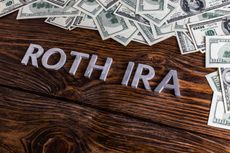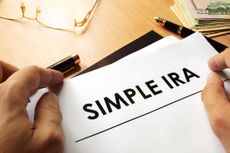When Not to Roll Over a 401(k) to an IRA
Comparing your investment choices and costs can aid in deciding if a rollover is the right move.


When leaving your job, the conventional wisdom has long been to take your 401(k) money with you by rolling it into an IRA. And 95% of the time that’s the way to go, says Evan Beach, a certified financial planner for Campbell Wealth Management, in Alexandria, Va. But in some cases, taking the conventional route can be a costly mistake. Some retirees may be better off leaving their money in the 401(k) or finding another, better home for their assets.
The decision between leaving money in a 401(k) or rolling it over to an IRA can be as simple as comparing investment choices and costs. Sherry Johnson, 73, who lives in a suburb of Dallas, Tex., had rolled prior employer plans into an IRA when switching jobs. But when she left her final job five years ago, she found a good reason not to leave the 401(k). The plan offered a stable-value fund earning 3% in interest at the time. “It was a vehicle I couldn’t find on the open market,” says Johnson.
Johnson could have replicated just about every other investment choice with a rollover IRA, but not the stable-value fund. She considered the rate too good to give up. “I couldn’t find anything better,” she says. Even though the rate has dropped to 2.02%, it still beat the rate of a three-year certificate of deposit when Johnson recently reviewed her portfolio.

Sign up for Kiplinger’s Free E-Newsletters
Profit and prosper with the best of expert advice on investing, taxes, retirement, personal finance and more - straight to your e-mail.
Profit and prosper with the best of expert advice - straight to your e-mail.
While reviewing investment choices, also look at costs. Company plans typically invest in a mutual fund’s institutional shares, which are generally less expensive than retail shares. Besides fund costs, ask your employer’s benefits department about the administrative costs, says Terry Dunne, managing director of the rollover solutions group at Millennium Trust Co.
Company size can make a big difference in costs: Large company plans can spread the costs among more participants and can often negotiate better deals with custodians. “Small 401(k)s tend to be expensive,” says Beach. “If you have a big plan, say the [federal] Thrift Savings Plan or Boeing’s, costs are usually pretty low.”
Compare the costs of your 401(k) to an IRA to see which gives you the better deal. Beach points out that the fee war that fund firms have been waging has cut investing costs significantly for IRA investors.
Beyond choices and costs, there are other reasons to keep money in a 401(k). Covered by federal law, “401(k)s have strong creditor protection,” says Tom Zgainer, chief executive officer of America’s Best 401(k). IRAs are covered by state law, and the strength of creditor protection varies from state to state. Anyone who worries about being sued may prefer to have their money more strongly guarded.
Your age at retirement might also provide an incentive for keeping the 401(k). If you leave your job in, or after, the year you turn age 55, you can tap that employer’s plan without getting hit by the 10% early-withdrawal penalty. That penalty stretches to age 59½ for money in an IRA or any previous 401(k)s.
Late retirees can benefit from keeping money in their current employer plan, too. If you are still working past age 70½ and own less than 5% of the company, you don’t have to take required minimum distributions until you actually leave the job. You will still have to take RMDs from older 401(k)s you own and any traditional IRAs you own starting at age 70½. But see if your current company plan allows you to “roll in” money from other retirement accounts. That would allow you to avoid RMDs altogether until you retire.
If You Stick With Your 401(k)
Retirees who want to keep their money in a 401(k) should ask if costs will remain the same. Some plans require ex-employees to cover some administrative expenses.
But how easy it is to manage your money is also key. Besides being limited to preselected investment choices, companies may set other limitations. Quiz your benefits department on how distributions will work and how easily you can tap your money as you need it. For instance, if you need money monthly, but your plan will only allow annual distributions, you may need to rethink keeping money in your 401(k).
If, like Johnson, you own an IRA and a 401(k), you will have to take an annual RMD from each account. There is no mixing and matching RMDs between 401(k)s or between IRAs and 401(k)s. An owner of multiple IRAs can take the total IRA RMD out of any one or combination of the IRAs. An owner of multiple 401(k)s must take the RMD for each 401(k) separately.
And, says certified financial planner Jean Keener, of Keener Financial Planning, in Keller, Tex., “most 401(k)s usually will sell pro rata.” Instead of taking your distribution from one fund in your 401(k), the plan will sell investments based on the allocation of your account. If you have your assets distributed equally over five funds, 20% of your withdrawal amount would come from the sale of shares of each of the five funds, says Keener, who is also Johnson’s adviser.
One other hiccup with distributions from 401(k)s: inflexible tax withholding. Your former employer will automatically withhold a minimum of 20% from each plan distribution. With an IRA, you can choose to withhold no tax or a smaller percentage.
Besides being up to speed on your company plan’s rules for your distributions, check with your plan for its rules on what happens to the 401(k) money after you die. Find out how quickly named beneficiaries must empty the account. And be sure to ask whether heirs will be able to roll the account into an inherited IRA, so that they can stretch distributions over their own life expectancies.
Alternative Routes for 401(k) Rollovers
Keeping your money in your 401(k) might not be the right move for you. But if you do roll money out of your 401(k), don't assume you should roll all of it to a traditional IRA. Another type of account might make a better home for your rollover money.
Those who hold company stock in their 401(k) should consider rolling those shares into a taxable account to make use of a tax-saving break known as net unrealized appreciation, or NUA.
Here’s how it works: Say you have $100,000 of employer stock in your 401(k), with an original “cost basis” of $20,000 and $80,000 of unrealized appreciation. You move the company stock to a taxable account and owe ordinary income tax—of up to 39.6%—on the $20,000. As you sell shares from the taxable account, you will owe tax on the appreciation at the long-term capital-gains rate of no more than 20%, and perhaps 0% depending on your income.
In other cases, you should roll 401(k) money into a Roth IRA. A few years ago, the IRS said it was okay for taxpayers to isolate any after-tax contributions made to the traditional 401(k) and roll them directly to a Roth IRA. No pro rata calculation needs to be figured in this type of conversion, so the after-tax contributions move to a Roth with no tax bill triggered.
And if you aren’t retiring, but moving to a new job in your second act, you might want to roll money from your former employer’s 401(k) directly into your new employer’s 401(k). That will stave off RMDs if you are working past age 70½, and it can open up opportunities such as the “backdoor Roth.” That move lets high earners who can’t make direct Roth contributions put money into a Roth IRA.
By using the 401(k) strategically, high earners can do those Roth conversions tax-free. But it takes a few steps: You would have to roll all your deductible IRA contributions into the 401(k). That would leave only nondeductible contributions in your traditional IRA, which can later be converted tax-free to a Roth IRA.
Get Kiplinger Today newsletter — free
Profit and prosper with the best of Kiplinger's advice on investing, taxes, retirement, personal finance and much more. Delivered daily. Enter your email in the box and click Sign Me Up.

-
 New Apple iPhone Update Helps Protect Your Security
New Apple iPhone Update Helps Protect Your SecurityThe new Apple iPhone update that hit phones recently helps protect yourself with security fixes.
By Alexandra Svokos Published
-
 Stock Market Today: The S&P 500 Reclaims the 6K Level
Stock Market Today: The S&P 500 Reclaims the 6K LevelInvestors see Scott Bessent as a safe shepherd of the economy as the president-elect burnishes his "Tariff Man" reputation.
By David Dittman Published
-
 457 Plan Contribution Limits for 2025
457 Plan Contribution Limits for 2025Retirement plans There are higher 457 plan contribution limits for state and local government workers in 2025 than in 2024.
By Kathryn Pomroy Last updated
-
 Medicare Basics: 11 Things You Need to Know
Medicare Basics: 11 Things You Need to KnowMedicare There's Medicare Part A, Part B, Part D, Medigap plans, Medicare Advantage plans and so on. We sort out the confusion about signing up for Medicare — and much more.
By Catherine Siskos Last updated
-
 Six of the Worst Assets to Inherit
Six of the Worst Assets to Inheritinheritance Leaving these assets to your loved ones may be more trouble than it’s worth. Here's how to avoid adding to their grief after you're gone.
By David Rodeck Last updated
-
 SEP IRA Contribution Limits for 2024 and 2025
SEP IRA Contribution Limits for 2024 and 2025SEP IRA A good option for small business owners, SEP IRAs allow individual annual contributions of as much as $69,000 in 2024 and $70,000 in 2025..
By Jackie Stewart Last updated
-
 Roth IRA Contribution Limits for 2024 and 2025
Roth IRA Contribution Limits for 2024 and 2025Roth IRAs Roth IRA contribution limits have gone up. Here's what you need to know.
By Jackie Stewart Last updated
-
 SIMPLE IRA Contribution Limits for 2024 and 2025
SIMPLE IRA Contribution Limits for 2024 and 2025simple IRA The SIMPLE IRA contribution limit increased by $500 for 2025. Workers at small businesses can contribute up to $16,500 or $20,000 if 50 or over and $21,750 if 60-63.
By Jackie Stewart Last updated
-
 457 Contribution Limits for 2024
457 Contribution Limits for 2024retirement plans State and local government workers can contribute more to their 457 plans in 2024 than in 2023.
By Jackie Stewart Published
-
 Roth 401(k) Contribution Limits for 2025
Roth 401(k) Contribution Limits for 2025retirement plans The Roth 401(k) contribution limit for 2024 is increasing, and workers who are 50 and older can save even more.
By Jackie Stewart Last updated